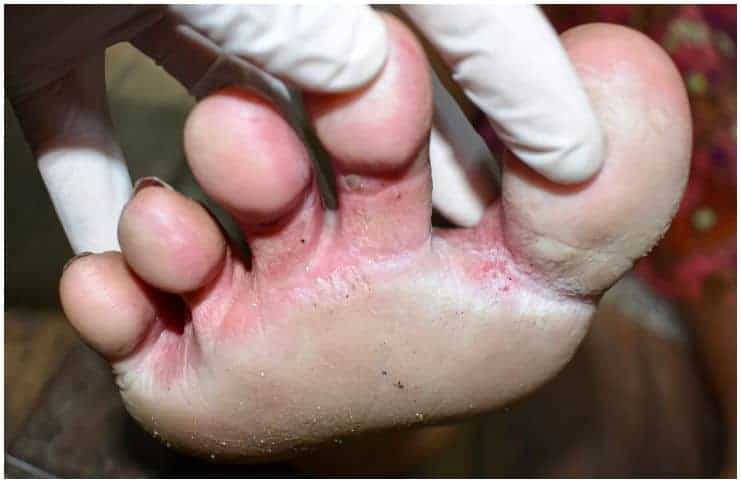Tinactin
It is the brand name of a medication called tolnaftate, an antifungal medication which fights infections caused by fungus.
This medication is supplied as a powder, spray, cream, and liquid aerosol.
Mechanism of Action
It works by inhibiting squalene epoxidase, an important enzyme in the synthesis of ergosterol.
Uses
This medication is used with other antifungals to treat infections of the scalp, palms, nails, and soles of the feet. In addition, it is used to treat infections, like – jock itch (tinea cruris), athlete’s foot (tinea pedis), and ringworm (tinea corporis).
Note – it is not recommended for the treatment of deeper skin infections or infection of the nail beds (onychomycosis).
Dosage
The usual recommended dose is 3 to 4 drops into the affected area 4 times per day for 7 days.
Note – if this antifungal gets in your mouth, rectum, eyes, nose, or vagina, rinse with water. Also, do not use this antifungal on open wounds or on windburned, sunburned, chapped, dry, or irritated skin.
Side Effects and Precautions
Common side effects may include:
- dryness, mild itching, or peeling of treated skin.
Rare side effects may include:
- trouble breathing;
- severe dizziness;
- itching/swelling of the face/tongue/throat.
Alcohol
Avoid drinking alcoholic beverages while taking this medication since alcohol use can increase the risk of side effects.
Drug Interactions
It may negatively interact with other medications, especially:
- Synthroid (levothyroxine);
- Aspirin Low Strength (aspirin);
- Tylenol (acetaminophen);
- Benadryl (diphenhydramine);
- ProAir HFA (albuterol);
- Symbicort (budesonide/formoterol);
- beclomethasone (a steroid medication that prevents the release of substances in the human body that cause inflammation);
- Cymbalta (duloxetine);
- Lyrica (pregabalin);
- Nexium (esomeprazole);
- metronidazole;
- MiraLax (polyethylene glycol 3350);
- Lipitor (atorvastatin);
- uricalm;
- Singulair (montelukast);
- fluconazole (an antifungal medication used for the treatment of numerous fungal infections);
- Advair Diskus (fluticasone/salmeterol);
- hydrocortisone (a medication that is used to treat adrenocortical deficiency);
- Lasix (furosemide);
- azo;
- betamethasone.
Pregnancy & Breastfeeding
It is not known exactly whether this medication passes into breast milk or if it could negatively affect a nursing infant. Do not use this antifungal without a healthcare professional’s advice if you are breastfeeding an infant.
Additionally, there are no well-done studies to determine the safety of this medication in pregnancy. Tell your doctor that you are pregnant or plan to fall pregnant before using this medicine.
Lotrimin
It is the brand name of a drug called clotrimazole, which belongs to a group of drugs known as antifungals.
This medication works by inhibiting the growth of infection-causing yeast.
Uses
This medication is found both as an OTC and a prescription. The over-the-counter form is used to treat yeast infections of the skin and the vagina. The prescription form is used to treat yeast infections of the mouth and skin.
READ MORE: No Doz vs Vivarin
Dosage
It comes as a powder, a vaginal tablet, cream, lotion, and lozenge.
The lozenge form is usually given 5 times per day for 2 weeks. The cream, lotion, or solution forms are applied to the affected area two times a day.
Side Effects and Precautions
Common side effects may include:
- redness or peeling at the site of application;
- burning at the site of the application.
Rare side effects may include:
- stomach pain;
- fever;
- nausea;
- vomiting.
Alcohol
It is recommended to avoid consuming alcoholic beverages while taking this antifungal since alcohol use can increase the risk of side effects.
READ MORE: Bengay vs Icy Hot
Drug Interactions
It may negatively interact with other medications, especially:
- Aspirin Low Strength (aspirin);
- Benadryl (diphenhydramine);
- Symbicort (budesonide/formoterol);
- Cymbalta (duloxetine);
- Nexium (esomeprazole);
- MiraLax (polyethylene glycol 3350);
- Singulair (montelukast);
- Advair Diskus (fluticasone/salmeterol);
- betamethasone;
- Synthroid (levothyroxine);
- Lasix (furosemide);
- hydrocortisone;
- fluconazole;
- Tylenol (acetaminophen);
- Lipitor (atorvastatin);
- Lyrica (pregabalin);
- metronidazole;
- ProAir HFA (albuterol);
- beclomethasone.
Pregnancy & Breastfeeding
This antifungal is passed through breast milk and may negatively affect the breastfed infant. Tell your healthcare professional that you are breastfeeding a baby before use.
Also, this medication may negatively affect an unborn baby. Tell your healthcare professional if you are pregnant or plan to fall pregnant before using this antifungal.
READ MORE: Lamisil vs Lotrimin
Bottom Line – Tinactin vs Lotrimin
Tinactin (active ingredient – tolnaftate) is a medication that is used to treat skin infections, like jock itch, athlete’s foot, and ringworm. This antifungal works by preventing the growth of fungus.
Lotrimin (active ingredient – clotrimazole) is an antifungal that is used to treat skin infections, like athlete’s foot, yeast infections, jock itch, and ringworm.
They are both topical antifungal preparations but with different active ingredients. Also, they are both used for topical fungal infections and have similar effectiveness.
Regarding their price, the average retail price for Tinactin is $27, while the average retail price for Lotrimin is $25.
READ THIS NEXT: Kerydin vs Jublia
References https://www.ncbi.nlm.nih.gov/pubmed/5338033 https://jamanetwork.com/journals/jama/article-abstract/1165889?redirect=true https://academic.oup.com/mmy/article-abstract/24/2/155/954625?redirectedFrom=PDF
